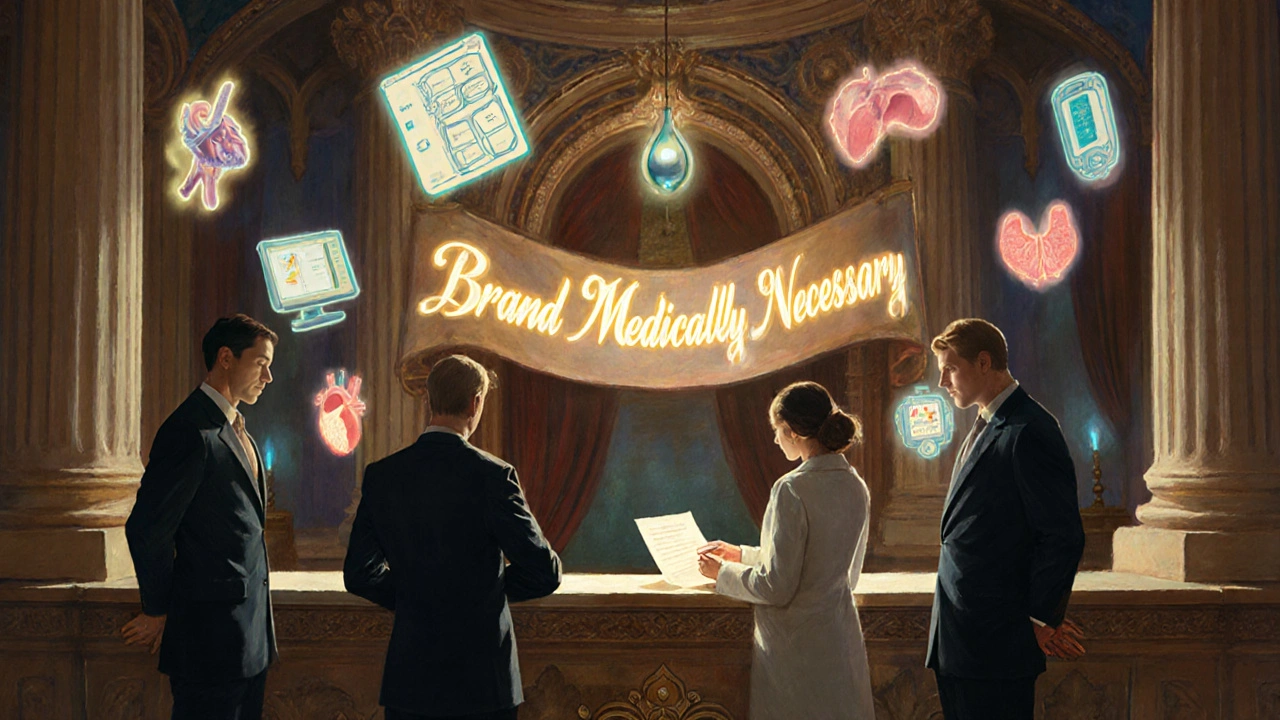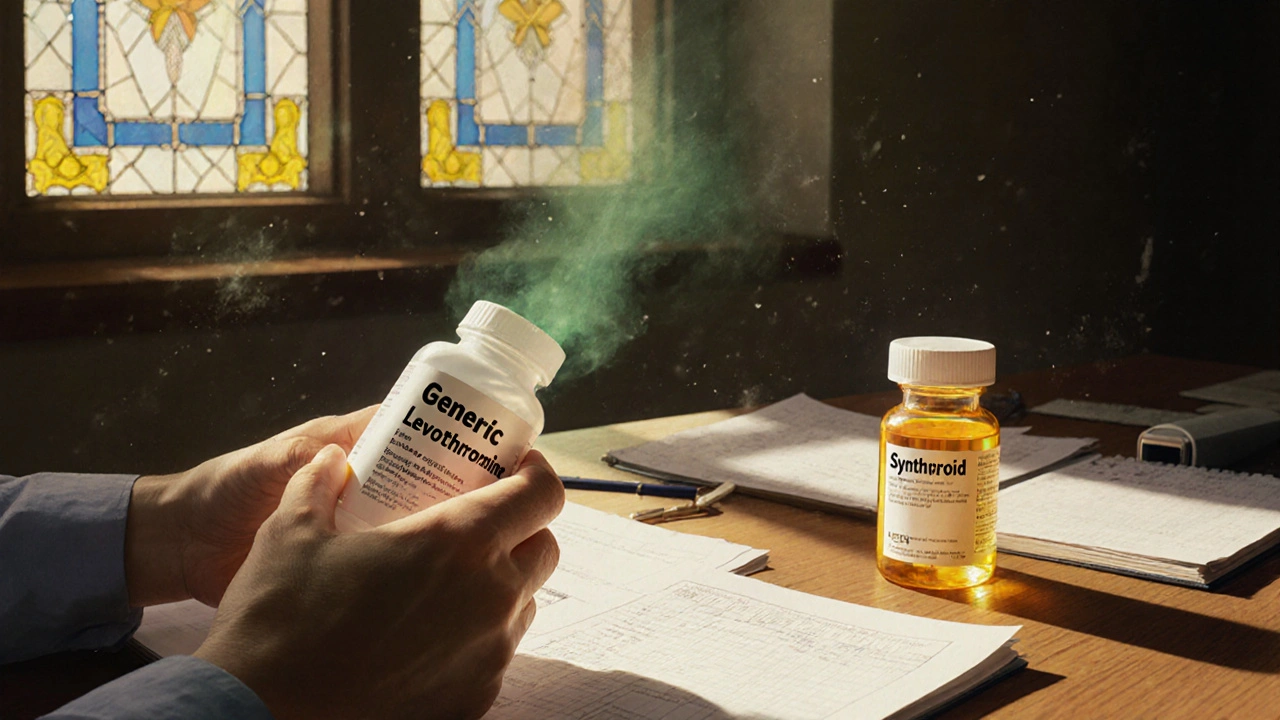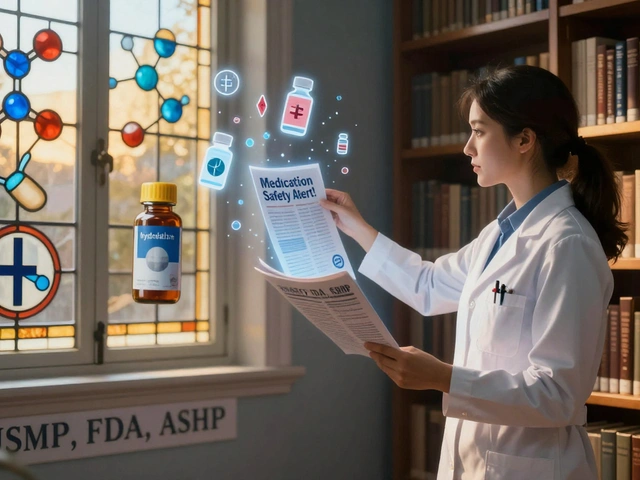Most people assume generic medications are just as good as brand-name drugs-and for the vast majority, they are. But what if you’re one of the few who starts feeling worse after switching? Maybe you get headaches, a rash, or your condition suddenly isn’t under control. You didn’t choose the switch-your pharmacy did, because it’s cheaper. Now you’re stuck wondering: how do you switch back from a generic to a brand safely?
Why Switching Back Might Be Necessary
Generic drugs are required by the FDA to have the same active ingredient, strength, and dosage form as the brand. They must also be bioequivalent, meaning they deliver the same amount of medicine into your bloodstream within a range of 80% to 125% of the brand’s performance. Sounds fair, right? But here’s the catch: generics can have different inactive ingredients. These include fillers, dyes, preservatives, and coatings. For most people, these don’t matter. But for some, they trigger reactions. A 2021 FDA analysis found that 14.3% of medication-related adverse events linked to switching involved changes in inactive ingredients. One patient might develop a rash from FD&C Yellow No. 5 in a generic version of a blood pressure pill. Another might notice their thyroid levels fluctuate after switching from Synthroid to a generic levothyroxine. Narrow therapeutic index drugs-like warfarin, levothyroxine, lithium, and certain seizure medications-are especially sensitive. Even tiny changes in how the drug is absorbed can lead to serious problems: a stroke, a seizure, or organ rejection in transplant patients. The FDA recommends tighter bioequivalence standards (90%-111%) for these drugs, but not all generics meet that stricter threshold.When It’s Medically Necessary
Doctors don’t switch patients back to brand drugs just because they ask. There needs to be clear evidence that the generic isn’t working-or is causing harm. This is called therapeutic failure. Examples include:- INR levels swinging wildly on warfarin after switching generics
- Thyroid-stimulating hormone (TSH) levels rising despite stable dosing on generic levothyroxine
- New or worsening seizures after switching antiepileptic drugs
- Unexplained rash, swelling, or GI upset that disappeared after going back to the brand
How to Start the Process
Switching back isn’t as simple as asking your pharmacist. You need a plan. Here’s how to do it right:- Track your symptoms. Keep a daily log: when you switched, what changed, and how you felt. Include lab values if applicable. This isn’t optional-it’s your proof.
- Talk to your doctor. Don’t just say, “I want the brand.” Say, “My INR went from 2.3 to 4.1 two weeks after switching to the generic. I’ve been stable on Synthroid for years. I think the generic is causing instability.”
- Ask for a “Brand Medically Necessary” prescription. Your doctor must write “Dispense as Written” or “DAW-1” on the prescription. Some EHR systems now require them to check a box labeled “Brand Medically Necessary.”
- Specify the exact brand name. Don’t say “the brand.” Say “Synthroid 50 mcg” or “Lipitor 20 mg.” There are multiple brands and authorized generics. Precision matters.
- Request therapeutic monitoring. For drugs like warfarin or levothyroxine, your doctor should schedule follow-up blood tests within 7-10 days after the switch.
- Prepare for insurance hurdles. Most plans require prior authorization. Your doctor will need to submit clinical notes, lab results, and a letter explaining why the generic failed.
- Follow up with the pharmacy. Some pharmacists refuse to fill brand-name prescriptions without extra paperwork. Call ahead. Ask if they need a prior auth form or a signed letter from your doctor.

Insurance and Costs: The Real Barrier
This is where most people get stuck. Brand-name drugs cost 3 to 5 times more than generics. A monthly supply of Synthroid might be $120. The generic? $12. Insurance companies don’t want to pay the difference unless forced. In 2023, Medicare Part D denied 68% of brand-name requests when a generic was available. Blue Cross Blue Shield had denial rates as high as 82% according to patient reports. But here’s the good news: if you appeal with solid documentation, 63.7% of denials are overturned. What helps? A letter from your doctor that includes:- Specific clinical failure (e.g., “TSH increased from 1.8 to 6.2 after switching”)
- Previous stability on the brand
- Exclusion of other causes (e.g., no diet changes, no new medications)
- Reference to FDA guidelines on narrow therapeutic index drugs
What Can Go Wrong
Switching back isn’t risk-free. If you stop the generic cold turkey and switch without monitoring, you could experience withdrawal symptoms or loss of control over your condition. For example, patients switching back from generic levothyroxine to Synthroid sometimes report temporary fatigue or palpitations as their body adjusts to the new formulation. Pharmacies can also make mistakes. In 2022, the FDA recorded 1,247 medication errors related to switching. The most common? Pharmacists filling the wrong product because the prescription didn’t clearly say “brand medically necessary.” And while switching back can fix problems, it’s not always the answer. A 2022 study in Neurology found that patients with epilepsy who switched between different generics-or back to brand-had a 27% higher chance of breakthrough seizures. That’s why some experts warn against switching back for seizure meds unless absolutely necessary.Real Stories, Real Outcomes
One patient in Toronto, after months of fatigue and weight gain, discovered her generic levothyroxine had a different dye than her previous brand. She switched back to Synthroid after her endocrinologist documented her TSH levels. Her insurance denied it twice. She appealed with lab results. On the third try, they approved it. Within two weeks, her energy returned. Another man with atrial fibrillation kept having dangerous INR spikes after switching to a generic warfarin. His doctor wrote a letter citing FDA guidance on narrow therapeutic index drugs. His insurance approved it after 14 days. He now gets his brand-name warfarin without issue. But not everyone is so lucky. A Reddit user in Alberta shared how he waited three weeks for approval, missed two doses, and ended up in the ER with a blood clot. His story wasn’t unique. A 2023 KFF analysis found Medicare patients waited an average of 14.3 days for brand-name prior authorizations.
What to Do If You’re Denied
If your insurance denies the switch:- Ask for a written denial letter. It must state the reason.
- Submit a formal appeal. Include all your documentation.
- Ask your doctor to call the insurance company directly. Sometimes a phone call from a provider speeds things up.
- Check if your state has a “patient protection” law. Seventeen states require pharmacists to notify your doctor if you have an adverse reaction to a generic.
- Consider patient assistance programs. Some brand manufacturers offer discounts or free medication for those who qualify.
The Bottom Line
Switching back from a generic to a brand isn’t about preference. It’s about safety. For most people, generics work fine. But for those who react to inactive ingredients or have conditions that demand precision, the difference can be life-changing. The process is bureaucratic, slow, and frustrating. But it’s possible. You need documentation, persistence, and a doctor who understands the science behind it. Don’t accept “it’s just a generic” as an answer if your body is telling you otherwise. Your health isn’t a cost-saving experiment.Can I just ask my pharmacist to give me the brand instead of the generic?
No. Pharmacists are legally allowed to substitute generics unless the prescription says “Dispense as Written” or “DAW-1.” Even then, insurance may block it. You need a doctor’s note explaining why the brand is medically necessary. The pharmacist can’t override insurance rules.
Are brand-name drugs more effective than generics?
For most drugs, no. Bioequivalence standards ensure they work the same way. But for narrow therapeutic index drugs-like warfarin, levothyroxine, or seizure meds-small differences in inactive ingredients can affect absorption. In these cases, the brand may offer more consistent results because its formula rarely changes. Generics can switch manufacturers frequently, leading to variability.
How long does it take to get insurance approval to switch back?
It varies. Some approvals come in 2-3 days. Others take up to 14 days, especially with Medicare Part D. If you’re in a medical emergency-like unstable INR or seizures-your doctor can request an expedited review. Keep records of all delays; they help with appeals.
Can I switch back without my doctor’s help?
No. Switching medications without medical supervision can be dangerous, especially with drugs that have narrow therapeutic windows. Even if you feel better on the brand, your doctor needs to confirm it’s safe and document the reason. Insurance won’t cover it without their approval.
What if I can’t afford the brand even after approval?
Many brand manufacturers offer patient assistance programs. For example, Pfizer has one for Lipitor, and Sanofi offers savings cards for Lantus. Your doctor’s office can help you apply. Some pharmacies also have discount programs. Don’t skip your dose because of cost-talk to your provider about alternatives.
Is it safe to switch back and forth between generic and brand?
It’s not recommended. Each switch introduces variability. For drugs like levothyroxine or warfarin, frequent switches increase the risk of instability. Once you switch back to the brand, stay on it unless your doctor advises otherwise. Consistency matters more than cost.







Comments
Andrew Forthmuller
12 November 2025Generic warfarin gave me nosebleeds for weeks. Switched back to brand. Done. No drama.
Danae Miley
13 November 2025Let me be clear: this isn't about preference. It's about pharmacokinetics. The FDA's 80-125% bioequivalence window is a joke for narrow therapeutic index drugs. I've seen TSH levels jump 300% after a generic switch-no change in dose, no change in diet, just a different filler. If your body reacts, it's not 'in your head.' It's chemistry. And if your doctor won't fight for you, find one who will.
Samantha Wade
14 November 2025Danae is absolutely right. I'm an endocrinologist, and I've had to write over 40 prior auth letters for levothyroxine switches in the past year alone. The data is undeniable: patients stabilized on Synthroid for years will see TSH drift upward after switching to a generic-sometimes within days. The inactive ingredients aren't inert. They alter dissolution rates. And for thyroid patients, that’s catastrophic. Insurance companies treat this like a billing issue. It’s not. It’s a clinical emergency waiting to happen. Document everything. Push back. You’re not being difficult-you’re being medically literate.
Renee Ruth
15 November 2025Ugh. I switched to generic levothyroxine last year because my insurance forced it. Three weeks later, I was in the ER with atrial fibrillation. My TSH was 14.8. My doctor said 'it's probably coincidence.' Coincidence? My symptoms vanished the moment I went back to Synthroid. Now I have to fight my insurance every single month. They deny it. I appeal. They deny it again. I appeal again. I'm exhausted. My life is now a paperwork nightmare because they think $108 is too much to pay for safety. I’m not asking for luxury. I’m asking not to die.
Elizabeth Buján
15 November 2025i just wanna say-i know how it feels. i switched generics for my seizure med and had a full-on seizure in the grocery store. no warning. just black. woke up on the floor with people staring. my neurologist said 'maybe it was the generic' and i cried because he finally believed me. i switched back. insurance denied it 3 times. i cried more. then i found a patient aid program. it’s not perfect. but i’m alive. and i’m not gonna apologize for needing the brand. my brain deserves better than a cost-cutting gamble.
Charles Lewis
17 November 2025It is imperative to recognize that the regulatory framework governing generic pharmaceuticals, while scientifically sound in principle, fails to account for the biological variability inherent in human physiology. The assumption that bioequivalence within an 80–125% range is universally safe overlooks the cumulative impact of excipient interactions in susceptible populations. Particularly in the case of anticoagulants and endocrine agents, where therapeutic margins are razor-thin, even marginal shifts in absorption kinetics can precipitate iatrogenic harm. The current system, driven by fiscal imperatives rather than clinical nuance, places undue burden on the patient to become an advocate, a researcher, and a legal petitioner-all while managing a chronic illness. This is not healthcare. This is bureaucratic triage disguised as efficiency.
vanessa k
18 November 2025I was on brand warfarin for 8 years. Insurance switched me without telling me. My INR went from 2.5 to 5.1 in 10 days. I started bleeding internally. My doctor didn’t even check my labs for two weeks because he trusted the 'bioequivalence' nonsense. I almost died. Now I get my brand. I fight every time. I don’t care if it costs more. I’m not a number in their spreadsheet. If you’re feeling off after a switch-don’t wait. Get your labs. Document everything. Your life matters more than their budget.
manish kumar
19 November 2025I’m from India, and here generics are the only option-but I’ve seen the same problem. A friend on lithium switched generics and developed tremors and confusion. Took three months to get back to the original brand. The system doesn’t care unless you scream. I’ve started a small support group for people on narrow therapeutic index drugs. We share prior auth templates, doctor letter samples, even how to call insurance reps without losing your mind. You’re not alone. There are others fighting this. Keep going. Your voice matters. And yes, the system is broken-but we’re slowly changing it, one appeal at a time.
Nicole M
20 November 2025My mom’s on Synthroid. Switched to generic. She got so tired she couldn’t walk to the mailbox. We switched back. Insurance denied. We appealed. Got approved on the 3rd try. Now I call the pharmacy every month to make sure they don’t swap it again. I don’t care if it’s 'just a pill.' If it’s the difference between walking and being bedridden, it’s worth it.